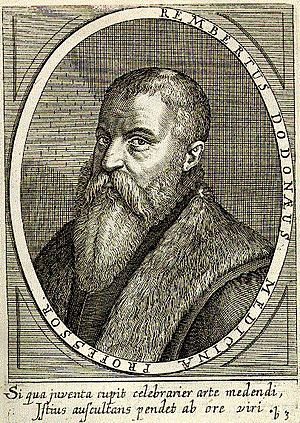Rembert Dodoens facts for kids
Quick facts for kids
Rembert Dodoens
|
|
|---|---|

Engraving by Theodor de Bry, in Bibliotheca chalcographica (1669)
|
|
| Born |
Rembert Van Joenckema
29 June 1517 Mechelen, Flanders (now Belgium)
|
| Died | 10 March 1585 (aged 67) Leiden, South Holland, The Netherlands
|
| Resting place | Pieterskerk, Leiden |
| Nationality | Flemish |
| Other names | Rembertus Dodonaeus |
| Alma mater | University of Leuven |
| Known for | Cruydboeck, a "Herbal" |
| Spouse(s) |
|
| Children | 5 |
| Parent(s) | Denis van Joenckema and Ursula Roelants |
| Scientific career | |
| Fields | Medicine, botany |
| Institutions | Mechelin, Vienna, Leiden University |
| Influences | Otto Brunfels, Jerome Bock, Leonhard Fuchs |
| Author abbrev. (botany) | Dodoens |
Rembert Dodoens (born Rembert Van Joenckema, 29 June 1517 – 10 March 1585) was a famous Flemish doctor and botanist. He was also known by his Latin name, Rembertus Dodonaeus. Many people call him the "father of botany" because of his important work with plants.
Contents
A Look at Rembert Dodoens' Life
Rembert Dodoens was born in Mechelen, which was then the capital of the Spanish Netherlands, in 1517. His parents were Denis van Joenckema and Ursula Roelants. His family came from a region called Friesland. Rembert later changed his last name to Dodoens. This new name meant "Son of Dodo," which was a short form of his father's name, Denis.
Early Education and Travels
Rembert went to school in Mechelen. When he was just 13 years old, he started studying medicine, cosmography (the study of the universe), and geography at the University of Leuven. He finished his medical studies in 1535.
Like many students back then, he traveled a lot around Europe until 1546. He visited countries like Italy, Germany, and France. In 1539, he married Kathelijne De Bruyn. She also came from a family of doctors. They had four children together. After Kathelijne passed away in 1572, he married Maria Saerinen, and they had a daughter.
Becoming a Doctor and Professor
In 1548, Dodoens followed in his father's footsteps and became one of the main doctors in Mechelen. He also worked as a doctor for important rulers, including the Holy Roman Emperor Maximilian II and Emperor Rudolph II in Vienna.
Later, in 1582, he became a professor of medicine at the University of Leiden. Rembert Dodoens passed away in Leiden in 1585 and was buried there.
How Plant Science Changed in Dodoens' Time
During Rembert Dodoens' life, people learned a lot more about plants. Before this time, many believed that all plants had already been described by an ancient Greek doctor named Dioscorides. But then, explorers started finding many new plants in places like the New World (the Americas).
The invention of the printing press also made a huge difference. It became easier to print books with pictures of plants. This time was like a "botanical Renaissance" (a rebirth of learning) for plant science.
A New Interest in Plants
From the 1530s, people across Europe became very interested in nature. Growing plants and creating gardens became popular, even among kings and queens. The first special gardens for plants (botanical gardens) started to appear. Also, the first illustrated books about plants were made, filled with thousands of drawings.
Farmers, gardeners, and doctors were learning more and more about plants. Collecting plants and studying natural things became popular for many people.
Doctors as Plant Experts
Many of the great plant experts of the 1500s, like Dodoens, were first trained as doctors. They studied plants not just for medicine, but because they were curious about them. Universities started creating special jobs for plant experts within their medical schools. This showed how important the study of plants was becoming. Scientists began to observe, record, and experiment with plants in a new, careful way.
Some important plant experts who came before Dodoens were Otto Brunfels, Jerome Bock, and Leonhard Fuchs. Dodoens learned from their work and continued to build on their discoveries.
Images for kids
See also
 In Spanish: Rembert Dodoens para niños
In Spanish: Rembert Dodoens para niños



